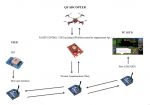Help Gps tracking quadcopter (grad project)
Hi everyone
I am new to these issues so I have few questions about my grad project. Let me describe it for you. we are asked to build an X type quadcopter that tracks a gps signal on a person and follows he/she in front of him/her (like lily drone). it will be act autonomusly. It stays in a stationary position when the user calls it, it has to hover at a certain altitude and has to maintain the tracking altitude of that person. the schematic is below. we are planning to use xbees for communications and
multiwii type flight controller which has(hold altitude,autopilot, magnetometer, sensors,etc. functions) I also figured out to use ppm encoder to convert data received from xbee pwm to ppm. I want this quadcopter to fly smoothly, strong enough to carry the items mentioned above. and we need to fly it from pc at first.
1. What steps should I follow for this project?
2. Which brand/model of a flight controller should I choose?
3. Do you suggest any Motor-ESC-Frame-Battery configuration?
4. Is it possible to do this project the way I mentioned above(any other(easier) methods)?
5. I know arduino but never written a code related to Xbee and GPS. how can I find codes to combine all devices?
6. How can I do PID settings on this configration?
I appreciate all help.
Hi everyone
I am new to these issues so I have few questions about my grad project. Let me describe it for you. we are asked to build an X type quadcopter that tracks a gps signal on a person and follows he/she in front of him/her (like lily drone). it will be act autonomusly. It stays in a stationary position when the user calls it, it has to hover at a certain altitude and has to maintain the tracking altitude of that person. the schematic is below. we are planning to use xbees for communications and
multiwii type flight controller which has(hold altitude,autopilot, magnetometer, sensors,etc. functions) I also figured out to use ppm encoder to convert data received from xbee pwm to ppm. I want this quadcopter to fly smoothly, strong enough to carry the items mentioned above. and we need to fly it from pc at first.

1. What steps should I follow for this project?
2. Which brand/model of a flight controller should I choose?
3. Do you suggest any Motor-ESC-Frame-Battery configuration?
4. Is it possible to do this project the way I mentioned above(any other(easier) methods)?
5. I know arduino but never written a code related to Xbee and GPS. how can I find codes to combine all devices?
6. How can I do PID settings on this configration?
I appreciate all help.
Last edited:

